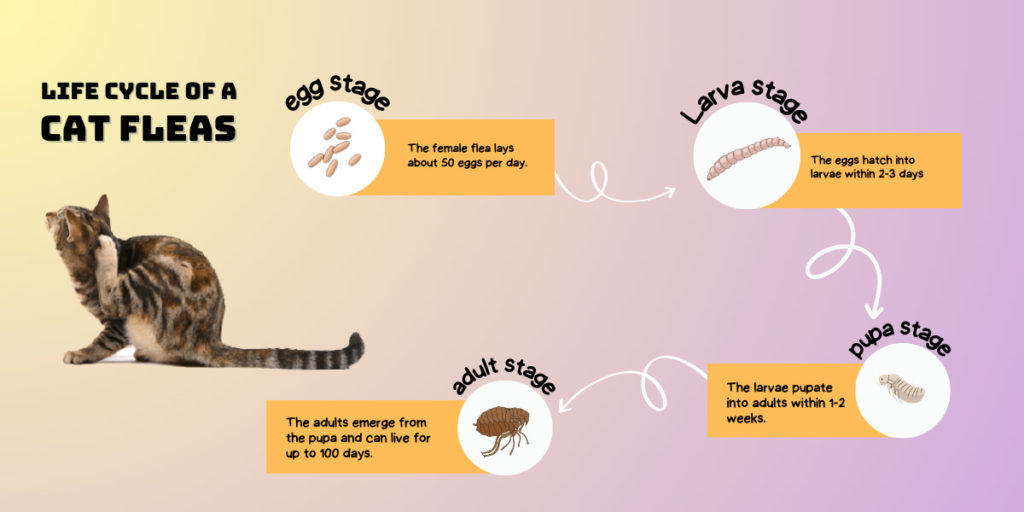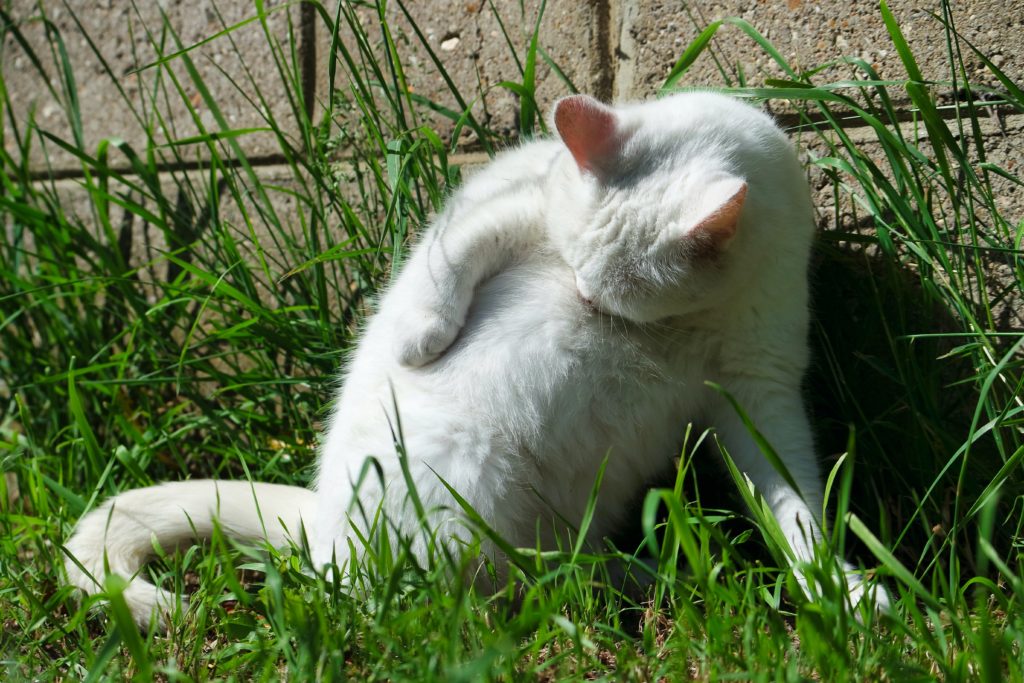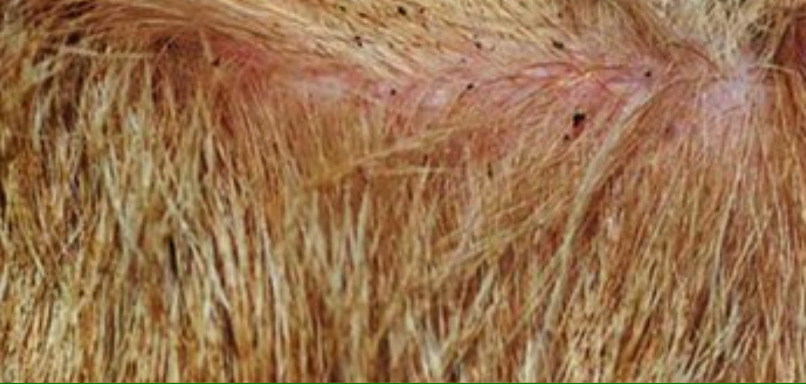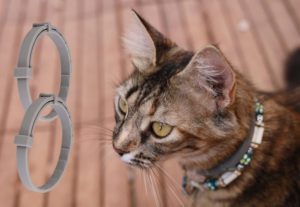Do you have a cat that is scratching and itching nonstop? Do you see tiny black dots or white specks in their fur or on their bed? If you answered yes to any of these questions, then you may have a flea problem. Fleas are not only annoying, but also harmful to your cat and your family. They can cause skin infections, allergies, and other diseases. That’s why you need to know how to groom your cat for flea prevention.
What are cat fleas and how do they affect your cat?
Cat fleas are small, wingless parasites that feed on the blood of cats and other animals. They can cause a variety of problems for your cat, such as:
- Itching and scratching
- Skin infections and inflammation
- Hair loss and bald patches
- Anemia (low red blood cell count)
- Tapeworm infection (if your cat swallows an infected flea)
- Flea allergy dermatitis (FAD), a severe allergic reaction to flea saliva that causes intense itching, redness, scabs and sores
Fleas can also transmit diseases to your cat, such as cat scratch disease, plague, typhus and bartonellosis.

How to tell if your cat has fleas
The best way to tell if your cat has fleas is to check their skin and fur regularly for signs of fleas or flea dirt. You can do this by:
- Using a fine-toothed flea comb to comb through your cat’s fur, especially around the base of the tail, the neck and the belly. Look for live fleas, flea eggs (white specks) and flea dirt (black specks) on the comb or on a white paper towel.
- Reverse rubbing your cat’s fur from tail to head to expose the skin underneath. Look for fleas, flea eggs, flea dirt or red bumps on the skin.
- Examining your cat’s bedding, furniture and carpets for signs of fleas, such as flea eggs, flea dirt or flea pupae (cocoons). You can use a vacuum cleaner or a lint roller to collect them.
If you find any evidence of fleas on your cat or in your environment, you should contact your veterinarian immediately to start the treatment process.
You can also visit our page on cat dandruff to learn more about how to identify and treat this common skin condition in cats.
What do fleas look like on cats?

Fleas are very small insects that can be hard to see on cats. They are usually dark brown or black in color and have a flattened body with three pairs of legs. They are about 1/8 of an inch long (1-3 mm) and look like tiny black dots.
Flea eggs are white and oval-shaped and look like grains of salt. They are about 0.5 mm in size and can be found in your cat’s fur or in their environment.
Flea dirt is the feces of fleas that contains digested blood. It looks like black pepper or coffee grounds and can be found in your cat’s fur or in their environment. If you wet a speck of flea dirt, it will turn red because of the blood.
Flea pupae are the cocoons that fleas make before they emerge as adults. They are sticky and brownish in color and look like grains of sand. They can be found in carpets, furniture or cracks in floors.

You can also check out our page on dry shampoo for cats to learn how to clean your cat’s fur and skin without water.
How to get rid of cat fleas

Getting rid of cat fleas requires treating both your cat and your home for fleas. You should:
- Treat your cat with a product that kills adult fleas and prevents them from laying eggs. You can choose from shampoos, sprays, powders, wipes, topical medications, oral medications or collars that are specially formulated for cats and fleas. Your veterinarian can help you select the best product for your cat based on their age, weight, health condition and lifestyle.
- Treat your home with a product that kills flea eggs, larvae and pupae in the environment. You can choose from foggers, sprays or powders that are designed for flea control. You should follow the directions on the label and keep your cat away from the treated areas until they are dry.
- Vacuum your carpets, rugs, furniture and floors regularly and dispose of the vacuum bag or empty the canister outside. This will help remove any remaining fleas or flea dirt from your home.
- Wash your cat’s bedding, toys and blankets in hot water and dry them on high heat at least once a week. This will help kill any fleas or eggs that may be hiding in them.
- Repeat the treatment process every month until you are sure that all fleas are gone from your cat and your home. Fleas have a life cycle that can last from two weeks to a year depending on the environmental conditions, so you need to be consistent and thorough to eliminate them completely.
Cat fleas treatment at home
If you prefer to use natural or homemade remedies to treat your cat for fleas, you can try some of the following options:
- Use a flea comb to remove fleas from your cat’s fur. Dip the comb in a bowl of soapy water or rubbing alcohol to kill the fleas.
- Give your cat a flea bath using a mild soap or shampoo that is safe for cats. You can also add some apple cider vinegar, lemon juice or essential oils (such as lavender, peppermint or rosemary) to the water to repel fleas.
- Apply a topical solution of apple cider vinegar, coconut oil or olive oil to your cat’s skin and fur. These substances can help moisturize and soothe your cat’s skin and repel fleas.
- Sprinkle some diatomaceous earth, baking soda or salt on your carpets and furniture. These substances can dehydrate and kill fleas by damaging their exoskeletons. You should vacuum them up after a few hours.
- Grow some flea repellent plants in your home or garden, such as lavender, mint or rosemary. These plants can deter fleas from entering your home or jumping on your cat.
However, you should be aware that natural or homemade remedies may not be as effective or safe as commercial products for flea control. Some of them may cause allergic reactions, irritation or toxicity in your cat or in yourself. You should always consult your veterinarian before using any natural or homemade remedy on your cat and test it on a small area of their skin first.
What is the fastest way to get rid of fleas on a cat?
The fastest way to get rid of fleas on a cat is to use a product that kills adult fleas and prevents them from laying eggs, such as a topical or oral medication. These products can start working within hours and provide protection for up to a month.
However, you should not rely on these products alone to get rid of fleas on your cat. You should also treat your home and environment for fleas, as most of the flea population lives off your cat. Use a product that kills flea eggs, larvae and pupae in the environment, such as a fogger, spray or powder. You should also vacuum and wash your cat’s bedding and belongings regularly.
You should repeat the treatment process every month until you are sure that all fleas are gone from your cat and your home. Fleas have a life cycle that can last from two weeks to a year depending on the environmental conditions, so you need to be consistent and thorough to eliminate them completely.
How to groom your cat for flea prevention
Grooming your cat regularly can help prevent flea infestations by removing dead hair, dirt and debris that may attract fleas. It can also help you detect any signs of fleas early and improve your cat’s skin and coat health.
You should groom your cat at least once a week using a brush or a comb that is suitable for their fur type. You should also use a flea comb to check for fleas every time you groom them.
If you find any fleas on your cat, you should give them a flea bath using a shampoo that is specially formulated for cats and fleas. Avoid using human shampoos or products that are meant for dogs, as they may be harmful to your cat.
You should also use a cat flea collar, a topical or oral medication, or a natural remedy to prevent fleas from re-infesting your cat after the bath.
You can also use cat grooming techniques to clean your cat’s fur and skin without water. This can help reduce the risk of flea infestations by removing dirt, oil and odor that may attract fleas. Choose a technique that is safe and effective for your cat and follow the instructions carefully.
You can also use cat dandruff shampoo to moisturize and soothe your cat’s skin if they have dry, flaky or irritated skin due to flea bites or allergies. You should choose a cat dandruff shampoo that is gentle and hypoallergenic for your cat and follow the instructions on the label.
Frequently Asked Questions(FAQs)
The most effective flea treatment for cats depends on your cat’s age, weight, health condition and lifestyle. There are different types of products that can kill adult fleas and prevent them from laying eggs, such as shampoos, sprays, powders, wipes, topical medications, oral medications or collars. Some products may work faster or longer than others, or have different side effects or contraindications. You should consult your veterinarian to help you select the best product for your cat based on their individual needs.
The time it takes for flea treatments to start working on cats varies depending on the type of product and the severity of the infestation. Some products, such as Capstar, can start killing fleas within 30 minutes and achieve more than 90% effectiveness within six hours. Other products, such as topical or oral medications, may take longer to reach their full effect but provide protection for up to a month.
Baking soda is one of the natural or homemade remedies that some people use to treat their cat for fleas. Baking soda can dehydrate and kill fleas by damaging their exoskeletons. You can sprinkle some baking soda on your carpets and furniture and then vacuum it up after a few hours. However, you should be aware that baking soda may not be as effective or safe as commercial products for flea control. Baking soda may cause allergic reactions, irritation or toxicity in your cat or in yourself if ingested or inhaled. You should always consult your veterinarian before using any natural or homemade remedy on your cat and test it on a small area of their skin first.
References:
- Flea Bites on Cats, and 9 Other Signs Your Cat Has Fleas (Sorry!) | https://be.chewy.com/signs-your-cat-has-fleas/
- Fleas on Cats: Signs, Prevention, Treatment, and More | https://bondvet.com/b/fleas-on-cats
- What Do Cat Fleas Look Like? | https://www.greatpetcare.com/parasites/what-do-cat-fleas-look-like/
- How to Remove Fleas From Your Pet | https://www.webmd.com/pets/remove-fleas-from-pet
With a passion for cats and years of experience in cat care and grooming, I have gained valuable insights and expertise that I want to share with other cat lovers. I believe that every cat deserves the best care possible, and through this platform, I aim to empower cat owners like you to provide the utmost love and care for your feline companions.



